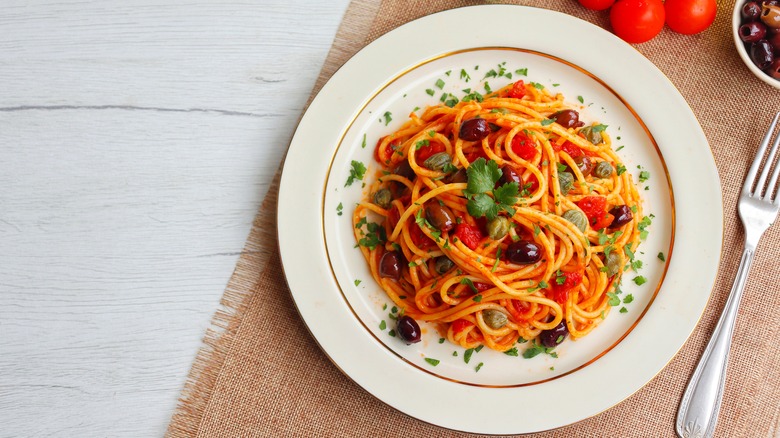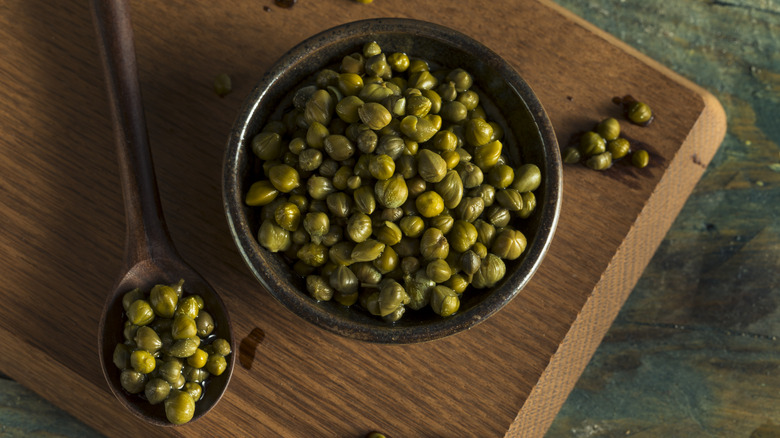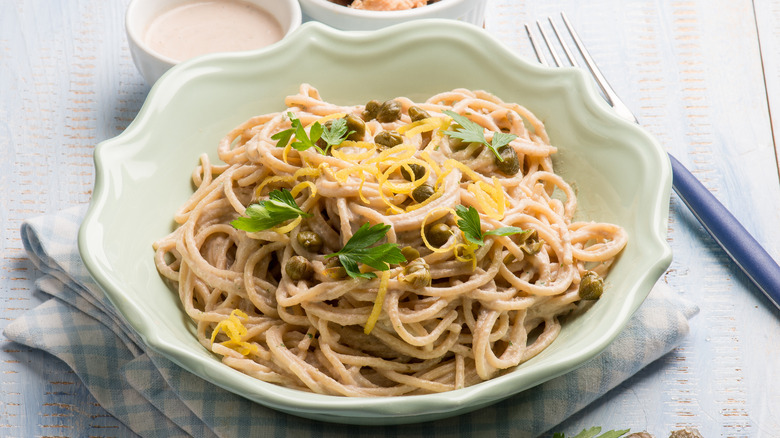Liven Up Bland Spaghetti Sauce With One Briny Ingredient
While jarred tomato sauce can be a real lifesaver when it comes to getting a meal on the table in a pinch, it can also be pretty humdrum. Fortunately, a one-note flavor profile can be instantly lifted with a secret ingredient you should be using in your spaghetti sauce — capers. You probably even already have a little jar lingering on your refrigerator door!
Capers can introduce a salty and acidic pop that takes tomato sauce from good to great. Use whole ones for a juicy burst or chopped if you prefer a more homogeneous sauce. Add capers at the end of cooking for a brighter acidity, or sautee them along with any veggies or aromatics first for a more rounded briny taste. These tiny bites introduce deep flavor, necessary balance, and a little something special to a simple dish. If capers are not your jam, reach for other tangy umami boosters for store-bought tomato sauce, like olives, cherry peppers, pickled mushrooms, or even a giardiniera medley to add a similar dimension.
Know your capers
There are several varieties of capers as well as a couple common preservation methods, and you should know how to treat them before you add them to your sauce. Capers are actually the dried and preserved immature flower buds from the caper bush. Much of how they are differentiated is based on size. Itty-bitty nonpareils are the smallest at less than a seven-millimeter diameter, followed by surfines, capucines, capotes, and fine grow, in that order. Grusas are the largest and include any capers that have a diameter greater than 14 millimeters.
Much of the capers available in the United States are brined in vinegar, which gives them a pronounced pucker. To use them, just strain the capers from the liquid. Many Italian products however are preserved in salt. They have more of a concentrated flavor, meatier texture, and a bit less tang. These need to be rinsed extremely thoroughly to remove excess salt.
Which you use really depends on your own preferences — both will be delicious when paired with tomatoes. In general, the larger they are, the more acidic they taste, so keep that in mind when choosing how much to add to your sauce. It is always a good idea to sample one on its own to get an idea.
Make capers the star of the show
Capers can amp up tomato sauce, but they can also take center stage. This is a great option for when you thought you had a leftover container ready-to-go, but you didn't realize how long an open jar of spaghetti sauce actually lasts in the fridge. Don't worry — just that tomato sauce is spoiled, not your dinner plans. Use capers to make a simple, oil-based, pantry pasta instead.
All you have to do is sautee capers along with your aromatics of choice, such as onions, garlic, or scallions in an ample amount of olive oil. Add in fresh or dried herbs, red pepper flakes, or Giada De Laurentiis' favorite Calabrian chili paste. Just make sure to keep the heat fairly low, so it does not burn. Toss with cooked spaghetti, a little pasta water, and a sprinkle of parmesan cheese, and you've got dinner on the table in the time it took you to cook the pasta.
This is also ideal for using up the leftover dregs of a store-bought sauce, a few lingering cherry tomatoes, or the last bit of a can of tomato paste. You can also incorporate more punchy flavors with anchovies, miso paste, or any number of pickled bites. Vegetables you have lying around like kale, spinach, cauliflower, or summer squash will all also pair well here. Use this preparation as a base, and adjust depending on what you have on hand. The capers will brighten just about any sauce.



